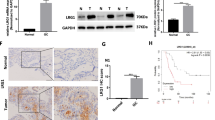Abstract
This study was aimed to evaluate the regulation mechanism of cortactin (CTTN) on matrix metalloproteinases 9 (MMP-9) and its relations with Exo70 in invasion of hepatoma carcinoma (HCC) cells. The expression levels of CTTN, Exo70 and MMP-9 were detected in normal hepatocytes and various HCC cells by real-time PCR. Then the migration and invasion ability of these cells was revealed by scratch and invasion assay. The effects of CTTN on MMP-9 and the ability of migration and invasion were evaluated by silence and overexpress CTTN. During this process, the expression of CTTN was detected by Western blot, the activity and concentration of MMP-9 in supernatant of culture medium was detected by zymography and ELISA assay. Besides, Exo70 was also inhibited to reveal its effects on MMP-9 and the migration and invasion ability of LM3. Increased expression of CTTN, MMP-9, Exo70, reduced scratch area and increased puncture cell numbers were found in HCC cells (p < 0.05). The expression of CTTN was significantly correlated with Exo70 and the migration and invasion ability of HCC (p < 0.05). In addition, the activity and concentration of MMP-9 were significantly affected by the expression level of CTTN, while the expression of MMP-9 was not influenced. Besides, Exo70-si also exhibited significantly inhibition effects on the activity and concentration of MMP-9 and puncture cell numbers (p < 0.05). A synergistic reaction may exhibited on CTTN and Exo70, which could mediate the secretion of MMPs thereby regulate tumor invasion.




Similar content being viewed by others
References
Perz JF, Armstrong GL, Farrington LA, Hutin YJ, Bell BP (2006) The contributions of hepatitis B virus and hepatitis C virus infections to cirrhosis and primary liver cancer worldwide. J Hepatol 45(4):529–538
Fonseca AL, Cha CH (2014) Hepatocellular carcinoma: a comprehensive overview of surgical therapy. J Surg Oncol 110(6):712–719
Terada T, Maruo H (2013) Unusual extrahepatic metastatic sites from hepatocellular carcinoma. Int J Clin Exp Pathol 6(5):816–820
Pinato DJ, Pirisi M, Maslen L, Sharma R (2014) Tissue biomarkers of prognostic significance in hepatocellular carcinoma. Adv Anat Pathol 21(4):270–284
Wan L, Pantel K, Kang Y (2013) Tumor metastasis: moving new biological insights into the clinic. Nat Med 19(11):1450–1464
Steeg PS (2006) Tumor metastasis: mechanistic insights and clinical challenges. Nat Med 12(8):895–904
Zitka O, Kukacka J, Krizkova S, Huska D, Adam V, Masarik M, Prusa R, Kizek R (2010) Matrix metalloproteinases. Curr Med Chem 17(31):3751–3768
Kessenbrock K, Plaks V, Werb Z (2010) Matrix metalloproteinases: regulators of the tumor microenvironment. Cell 141(1):52–67
Weaver AM (2008) Cortactin in tumor invasiveness. Cancer Lett 265(2):157–166
Clark ES, Whigham AS, Yarbrough WG, Weaver AM (2007) Cortactin is an essential regulator of matrix metalloproteinase secretion and extracellular matrix degradation in invadopodia. Cancer Res 67(9):4227–4235
Liu J, Yue P, Artym VV, Mueller SC, Guo W (2009) The role of the exocyst in matrix metalloproteinase secretion and actin dynamics during tumor cell invadopodia formation. Mol Biol Cell 20(16):3763–3771
Daphu I, Horn S, Stieber D, Varughese JK, Spriet E, Dale HA, Skaftnesmo KO, Bjerkvig R, Thorsen F (2014) In vitro treatment of melanoma brain metastasis by simultaneously targeting the MAPK and PI3 K signaling pathways. Int J Mol Sci 15(5):8773–8794
Zhou X, Xu G, Yin C, Jin W, Zhang G (2014) Down-regulation of miR-203 induced by Helicobacter pylori infection promotes the proliferation and invasion of gastric cancer by targeting CASK. Oncotarget 5(22):11631
Weidle UH, Birzele F, Kruger A (2015) Molecular targets and pathways involved in liver metastasis of colorectal cancer. Clin Exp Metastasis 32(6):623–635
Weaver AM (2006) Invadopodia: specialized cell structures for cancer invasion. Clin Exp Metastasis 23(2):97–105
Lu H, Liu J, Liu S, Zeng J, Ding D, Carstens RP, Cong Y, Xu X, Guo W (2013) Exo70 isoform switching upon epithelial-mesenchymal transition mediates cancer cell invasion. Dev Cell 27(5):560–573
He B, Guo W (2009) The exocyst complex in polarized exocytosis. Curr Opin Cell Biol 21(4):537–542
Yeaman C, Grindstaff KK, Wright JR, Nelson WJ (2001) Sec6/8 complexes on trans-Golgi network and plasma membrane regulate late stages of exocytosis in mammalian cells. J Cell Biol 155(4):593–604
Zuo X, Zhang J, Zhang Y, Hsu SC, Zhou D, Guo W (2006) Exo70 interacts with the Arp2/3 complex and regulates cell migration. Nat Cell Biol 8(12):1383–1388
Acknowledgments
This study was supported by Scientific Research Fund of Chinese PLA Air Force General Hospital (NO. KZ2011017). The authors would like to thank Professor Xu Jin-bo, Beijing Key Laboratory of Blood Safety and Supply Technologies, for his assistance in providing open laboratory for the study.
Author information
Authors and Affiliations
Corresponding author
Ethics declarations
Conflicts of interest
The authors declare that they have no conflict of interest.
Rights and permissions
About this article
Cite this article
Zhao, G., Zhang, H., Huang, Z. et al. Cortactin and Exo70 mediated invasion of hepatoma carcinoma cells by MMP-9 secretion. Mol Biol Rep 43, 407–414 (2016). https://doi.org/10.1007/s11033-016-3972-4
Received:
Accepted:
Published:
Issue Date:
DOI: https://doi.org/10.1007/s11033-016-3972-4




